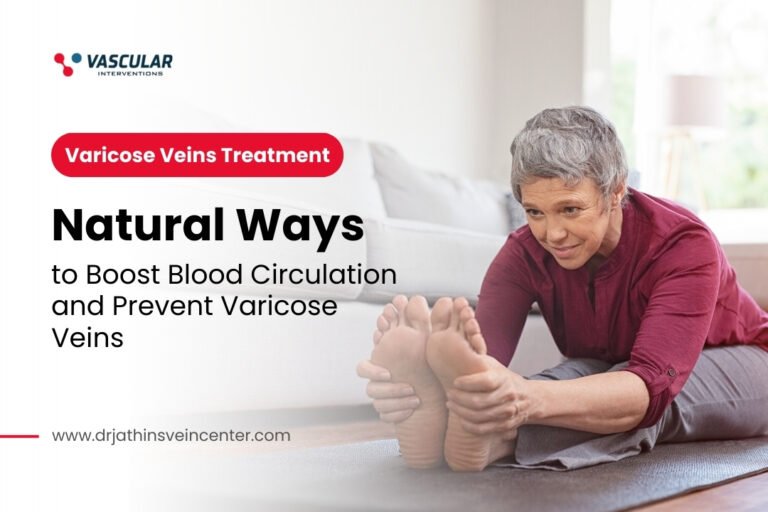What are the stages of Vein Disease?
Vein Disease is a medical condition in which a person’s veins are not properly returning blood from the legs back to the heart.
Types of Vein Disease
- Varicose veins: – Varicose veins are swollen, enlarged or twisting veins that typically appear blue or dark purple.
- Spider Veins: – Spider veins can be blue, purple or red. They may appear in the form of thin lines, webs or branches. People sometimes also refer to them as thread veins. Typically they are not painful or harmful.
- Pulmonary Embolism: – A condition in which one or more arteries in the lungs become blocked by a blood clot. Pulmonary Embolism (PE) occurs when a blood clot gets stuck in an artery in the lung, blocking blood flow to the part of the lung. Blood clots most often start in the legs and travel up through the right side of the heart and into the lungs. This is called Deep Vein Thrombosis (DVT).
- Chronic vein insufficiency: – Chronic venous insufficiency occurs when your leg veins don’t allow blood to flow back up to your heart. Normally, the valves in your veins make sure that blood flows towards your heart but when these valves don’t work well, blood can also flow backwards. This can cause blood to collect (pool) in your legs.
Symptoms of Vein Disease
- Painful legs and feet.
- Bulging veins.
- Swollen ankles.
- Itching legs.
- Hot or burning ankle.
- Heaviness in the feet.
- Skin that looks discoloured or thick.
Diagnosis of vein disease
A definitive diagnosis of vein disease requires a clinical exam by a trained physician or diagnostician. The duplex ultrasound is one of the most common tests for diagnosing vein disease.
Duplex Ultrasound: – A duplex ultrasound is the most accurate diagnostic test for venous disease and combines the best of traditional ultrasound and Doppler ultrasound. The doctor or technician moves a transducer over the teat area to measure the speed and direction of the blood flow by bouncing sound off red blood cells. A computer program measures the reflection of the sound and creates pictures from the sound waves to assist the physician in diagnosing problems with the blood flow.
Stages of Vein Disease
Stage 1: Spider or Reticular Veins
The following factors may increase the chances of developing spider or reticular veins: –
- Family history.
- Prolonged standing or sitting.
- Pregnancy or menopause.
- Hormonal changes or imbalances.
- Obesity.
Stage 2: Varicose Veins
Varicose veins can cause pain, aching and discomfort.
Symptoms of varicose veins:-
- Bulging dark purple or blue veins.
- Veins that appear to be twisted and/or enlarged.
- Burning or itching legs.
- Aching or heaviness in the limbs.
- Pain after prolonged periods of standing.
- Skin discolouration.
- Hardening of the skin.
- Inflammation and swelling of the legs around the varicose veins.
- Bleeding or leaking veins.
Stage 3: Swelling
Stage 3 marks more advanced vein disease as swelling of the legs indicates a backflow in the venous system’s ability to reabsorb and circulate blood.
Symptoms of leg swelling/inflammation:-
- Tightness in valves or ankles Itchy legs.
- Tenderness or numbness near varicose veins.
- Discoloured, leathery-like skin near varicose veins.
- Pain when walking.
- Restless leg syndrome.
- Muscle spasms.
Cause of legs and ankle swelling:-
- Lack of exercise.
- Diet.
- High blood pressure.
- Heart disease.
- Chronic venous insufficiency disease.
- Deep Vein Thrombosis.
- Smoking.
Stage 4: Skin Discolouration (Lipodermatosclerosis)
Stage 4 of vein disease begins to impact the appearance of your skin as skin becomes thinner and discolouration is visible. It is important to note, at the advancing stage of vein disease your skin is more at risk for injury and will take longer to heal.
Symptoms of skin discolouration: –
- Skin takes on a brown, leathery texture.
- Skin thickening and/or hardening around varicose veins.
- Pain and/or swelling in legs and ankles.
- Legs tapering above the ankles.
Cause of skin discolouration:-
- Chronic venous insufficiency.
- Heart disease.
- Hormonal changes.
- Poor diet.
- Obesity.
- Standing or sitting for prolonged periods.
Stage 5: Ulcers and open wounds
Stage 5 is the most advanced stage of vein disease and is most often referred to as the ‘ leg ulcer stage’. At this stage, venous congestion prevents blood flow and nutrition to the skin, resulting in venous ulcers on the surface of the skin.
Categories of skin ulcers:-
- Venous stasis.
- Diabetic ulcers.
- Arterial ulcers.
Venous stasis ulcers make up 80% to 90% of leg ulcers, most going untreated. Ulcers form on the outside of the skin as a result of excess pressure from inside your veins. Doctors believe that the increased pressure cuts off blood flow to capillaries causing a build-up of white blood cells.
When there is the presence of excess white blood cells, the blood lacks oxygen and nutrition resulting in ulcers on the outside of the skin.
Symptoms of leg ulcers:-
- Open and painful sores on legs and ankles.
- Yellow/ Green leaking fluid from sores.
- Leg and/ or ankle swelling.
- Burning and itching legs.
- Aching or painful legs.
- Skin discolouration.
- Skin tightening around legs.
Causes of leg ulcers:-
- Chronic venous insufficiency disease.
- Varicose veins.
- Deep Vein Thrombosis.
- Diabetes Mellitus.
- Heart failure.
- Peripheral vascular disease.
- Pregnancy
- Obesity.





